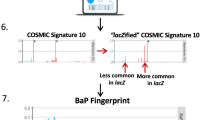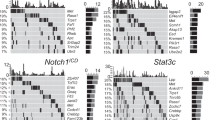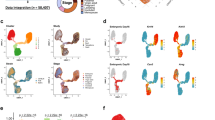Abstract
We performed a high-throughput retroviral insertional mutagenesis screen in mouse mammary tumor virus (MMTV)-induced mammary tumors and identified 33 common insertion sites, of which 17 genes were previously not known to be associated with mammary cancer and 13 had not previously been linked to cancer in general. Although members of the Wnt and fibroblast growth factors (Fgf) families were frequently tagged, our exhaustive screening for MMTV insertion sites uncovered a new repertoire of candidate breast cancer oncogenes. We validated one of these genes, Rspo3, as an oncogene by overexpression in a p53-deficient mammary epithelial cell line. The human orthologs of the candidate oncogenes were frequently deregulated in human breast cancers and associated with several tumor parameters. Computational analysis of all MMTV-tagged genes uncovered specific gene families not previously associated with cancer and showed a significant overrepresentation of protein domains and signaling pathways mainly associated with development and growth factor signaling. Comparison of all tagged genes in MMTV and Moloney murine leukemia virus–induced malignancies showed that both viruses target mostly different genes that act predominantly in distinct pathways.
This is a preview of subscription content, access via your institution
Access options
Subscribe to this journal
Receive 12 print issues and online access
$209.00 per year
only $17.42 per issue
Buy this article
- Purchase on Springer Link
- Instant access to full article PDF
Prices may be subject to local taxes which are calculated during checkout


Similar content being viewed by others
References
Nusse, R. & Varmus, H.E. Many tumors induced by the mouse mammary tumor virus contain a provirus integrated in the same region of the host genome. Cell 31, 99–109 (1982).
Johansson, F.K. et al. Identification of candidate cancer-causing genes in mouse brain tumors by retroviral tagging. Proc. Natl. Acad. Sci. USA 101, 11334–11337 (2004).
Mikkers, H. et al. High-throughput retroviral tagging to identify components of specific signaling pathways in cancer. Nat. Genet. 32, 153–159 (2002).
Suzuki, T. et al. New genes involved in cancer identified by retroviral tagging. Nat. Genet. 32, 166–174 (2002).
Chatterjee, G. et al. Acceleration of mouse mammary tumor virus-induced murine mammary tumorigenesis by a p53 172H transgene: influence of FVB background on tumor latency and identification of novel sites of proviral insertion. Am. J. Pathol. 161, 2241–2253 (2002).
Callahan, R. & Smith, G.H. MMTV-induced mammary tumorigenesis: gene discovery, progression to malignancy and cellular pathways. Oncogene 19, 992–1001 (2000).
Lazo, P.A., Lee, J.S. & Tsichlis, P.N. Long-distance activation of the Myc protooncogene by provirus insertion in Mlvi-1 or Mlvi-4 in rat T-cell lymphomas. Proc. Natl. Acad. Sci. USA 87, 170–173 (1990).
Lammie, G.A. et al. Proviral insertions near cyclin D1 in mouse lymphomas: a parallel for BCL1 translocations in human B-cell neoplasms. Oncogene 7, 2381–2387 (1992).
Sakatani, T. et al. Loss of imprinting of Igf2 alters intestinal maturation and tumorigenesis in mice. Science 307, 1976–1978 (2005).
van Roozendaal, C.E. et al. Loss of imprinting of IGF2 and not H19 in breast cancer, adjacent normal tissue and derived fibroblast cultures. FEBS Lett. 437, 107–111 (1998).
Shackleford, G.M., MacArthur, C.A., Kwan, H.C. & Varmus, H.E. Mouse mammary tumor virus infection accelerates mammary carcinogenesis in Wnt-1 transgenic mice by insertional activation of int-2/Fgf-3 and hst/Fgf-4. Proc. Natl. Acad. Sci. USA 90, 740–744 (1993).
Gallahan, D. & Callahan, R. Mammary tumorigenesis in feral mice: identification of a new int locus in mouse mammary tumor virus (Czech II)-induced mammary tumors. J. Virol. 61, 66–74 (1987).
Gallahan, D. & Callahan, R. The mouse mammary tumor associated gene INT3 is a unique member of the Notch gene family (Notch4). Oncogene 14, 1883–1890 (1997).
Takahashi, K., Mitsui, K. & Yamanaka, S. Role of ERas in promoting tumour-like properties in mouse embryonic stem cells. Nature 423, 541–545 (2003).
Zhang, S. et al. p16 INK4a gene promoter variation and differential binding of a repressor, the ras-responsive zinc-finger transcription factor, RREB. Oncogene 22, 2285–2295 (2003).
Erny, K.M., Peli, J., Lambert, J.F., Muller, V. & Diggelmann, H. Involvement of the Tpl-2/cot oncogene in MMTV tumorigenesis. Oncogene 13, 2015–2020 (1996).
Ceci, J.D. et al. Tpl-2 is an oncogenic kinase that is activated by carboxy-terminal truncation. Genes Dev. 11, 688–700 (1997).
Sourvinos, G., Tsatsanis, C. & Spandidos, D.A. Overexpression of the Tpl-2/Cot oncogene in human breast cancer. Oncogene 18, 4968–4973 (1999).
Chen, J.Z. et al. Cloning and identification of a cDNA that encodes a novel human protein with thrombospondin type I repeat domain, hPWTSR. Mol. Biol. Rep. 29, 287–292 (2002).
Lowther, W., Wiley, K., Smith, G.H. & Callahan, R. A new common integration site, Int7, for the mouse mammary tumor virus in mouse mammary tumors identifies a gene whose product has furin-like and thrombospondin-like sequences. J. Virol. 79, 10093–10096 (2005).
Adams, N.C., Tomoda, T., Cooper, M., Dietz, G. & Hatten, M.E. Mice that lack astrotactin have slowed neuronal migration. Development 129, 965–972 (2002).
Zagha, E. et al. DPP10 modulates Kv4-mediated A-type potassium channels. J. Biol. Chem. 280, 18853–18861 (2005).
Theodorou, V. et al. Fgf10 is an oncogene activated by MMTV insertional mutagenesis in mouse mammary tumors and overexpressed in a subset of human breast carcinomas. Oncogene 23, 6047–6055 (2004).
Dennis, G. Jr. et al. DAVID: database for annotation, visualization, and integrated discovery. Genome Biol. 4, P3 (2003).
Vogelstein, B. & Kinzler, K.W. Cancer genes and the pathways they control. Nat. Med. 10, 789–799 (2004).
van de Vijver, M.J. et al. A gene-expression signature as a predictor of survival in breast cancer. N. Engl. J. Med. 347, 1999–2009 (2002).
Payton, M., Scully, S., Chung, G. & Coats, S. Deregulation of cyclin E2 expression and associated kinase activity in primary breast tumors. Oncogene 21, 8529–8534 (2002).
Kwan, H. et al. Transgenes expressing the Wnt-1 and int-2 proto-oncogenes cooperate during mammary carcinogenesis in doubly transgenic mice. Mol. Cell. Biol. 12, 147–154 (1992).
Peters, G., Lee, A.E. & Dickson, C. Concerted activation of two potential proto-oncogenes in carcinomas induced by mouse mammary tumour virus. Nature 320, 628–631 (1986).
Dontu, G. et al. Role of Notch signaling in cell-fate determination of human mammary stem/progenitor cells. Breast Cancer Res. 6, R605–R615 (2004).
Kazanskaya, O. et al. R-Spondin2 is a secreted activator of Wnt/beta-catenin signaling and is required for Xenopus myogenesis. Dev. Cell 7, 525–534 (2004).
Kim, K.A. et al. Mitogenic influence of human R-spondin1 on the intestinal epithelium. Science 309, 1256–1259 (2005).
Liu, Y.J., Xu, Y. & Yu, Q. Full-length ADAMTS-1 and the ADAMTS-1 fragments display pro- and antimetastatic activity, respectively. Oncogene 25, 2452–2467 (2006).
Takeuchi, J.K. et al. Tbx5 and Tbx4 trigger limb initiation through activation of the Wnt/Fgf signaling cascade. Development 130, 2729–2739 (2003).
Prasad, V. et al. Haploinsufficiency of Atp2a2, encoding the sarco(endo)plasmic reticulum Ca2+-ATPase isoform 2 Ca2+ pump, predisposes mice to squamous cell tumors via a novel mode of cancer susceptibility. Cancer Res. 65, 8655–8661 (2005).
Bissell, M.J. & Radisky, D. Putting tumours in context. Nat. Rev. Cancer 1, 46–54 (2001).
Tlsty, T.D. Stromal cells can contribute oncogenic signals. Semin. Cancer Biol. 11, 97–104 (2001).
Wu, X., Li, Y., Crise, B. & Burgess, S.M. Transcription start regions in the human genome are favored targets for MLV integration. Science 300, 1749–1751 (2003).
Dupuy, A.J., Akagi, K., Largaespada, D.A., Copeland, N.G. & Jenkins, N.A. Mammalian mutagenesis using a highly mobile somatic Sleeping Beauty transposon system. Nature 436, 221–226 (2005).
Penault-Llorca, F. et al. Expression of FGF and FGF receptor genes in human breast cancer. Int. J. Cancer 61, 170–176 (1995).
Sjoblom, T. et al. The consensus coding sequences of human breast and colorectal cancers. Science 314, 268–274 (2006).
van der Valk, M.A. Tumor incidence of the inbred mouse strains in the Netherlands Cancer Institute. in Mammary Tumors in the Mouse 45–115 (Elsevier, Amsterdam, 1981).
Hynes, N.E., Groner, B., Diggelmann, H., van Nie, R. & Michalides, R. Genomic location of mouse mammary tumor virus proviral DNA in normal mouse tissue and in mammary tumors. Cold Spring Harb. Symp. Quant. Biol. 44, 1161–1168 (1980).
Devon, R.S., Porteous, D.J. & Brookes, A.J. Splinkerettes–improved vectorettes for greater efficiency in PCR walking. Nucleic Acids Res. 23, 1644–1645 (1995).
Jonkers, J. & Berns, A. Retroviral insertional mutagenesis as a strategy to identify cancer genes. Biochim. Biophys. Acta 1287, 29–57 (1996).
Merlo, G.R. et al. Growth suppression of normal mammary epithelial cells by wild-type p53. Ann. NY Acad. Sci. 698, 108–113 (1993).
Sheskin, D. Handbook of Parametric and Nonparametric Statistical Procedures (CRC Press New York, 1997).
Pavlidis, P. Using ANOVA for gene selection from microarray studies of the nervous system. Methods 31, 282–289 (2003).
Roberts, C.J. et al. Signaling and circuitry of multiple MAPK pathways revealed by a matrix of global gene expression profiles. Science 287, 873–880 (2000).
Acknowledgements
We are grateful to J. Hodzic, S. Bousata and P. van Schouwenburg for help with the insertional mutagenesis assay, M. Mandjes and D. Nuyten for help with the computational analyses and M. Voorhoeve for his critical comments. Parts of this study were performed for the thesis of M. K. at the medical faculty of Ludwig-Maximilians-Universität München. This work was supported by the Dutch Cancer Society (grant 2001-2489).
Author information
Authors and Affiliations
Contributions
V.T. developed the insertional mutagenesis screening protocol; performed a large part of the screen, the computational and expression analyses and gene cloning and wrote most of the manuscript. M.A.K. contributed to the development of the screening protocol, performed a substantial part of the insertional mutagenesis screen and performed some of the DNA blots. W.T. contributed to the insertional mutagenesis screen and expression analysis. M.B. performed the animal experiments and contributed to the tissue culture work. L.W. performed the statistical analyses. J.J. gave advice, contributed in the writing of the manuscript and performed some of the DNA blotting experiments. J.H. designed the study and contributed to the retroviral transduction and animal experiments and the writing of the manuscript.
Corresponding author
Ethics declarations
Competing interests
The authors declare no competing financial interests.
Supplementary information
Supplementary Fig. 1
Expression analysis of candidate cancer genes. (PDF 805 kb)
Supplementary Fig. 2
Oligoclonality of the Rspo3- and Wnt-induced tumors. (PDF 493 kb)
Supplementary Table 1
MMTV proviral insertion sites and associated genes. (PDF 309 kb)
Supplementary Table 2
Expression analysis of MMTV-tagged genes. (PDF 39 kb)
Supplementary Table 3
NIH-DAVID Gene Ontology analysis of MMTV-targeted genes. (PDF 62 kb)
Supplementary Table 4
Gene Ontology analysis of MULV-tagged genes in lymphomas using NIH-DAVID. (PDF 15 kb)
Supplementary Table 5
Gene Ontology analysis of MULV-tagged genes in brain tumors using NIH-DAVID. (PDF 38 kb)
Supplementary Table 6
PCR primers. (PDF 22 kb)
Rights and permissions
About this article
Cite this article
Theodorou, V., Kimm, M., Boer, M. et al. MMTV insertional mutagenesis identifies genes, gene families and pathways involved in mammary cancer. Nat Genet 39, 759–769 (2007). https://doi.org/10.1038/ng2034
Received:
Accepted:
Published:
Issue Date:
DOI: https://doi.org/10.1038/ng2034
This article is cited by
-
Rspo2 exacerbates rheumatoid arthritis by targeting aggressive phenotype of fibroblast-like synoviocytes and disrupting chondrocyte homeostasis via Wnt/β-catenin pathway
Arthritis Research & Therapy (2023)
-
Notch signaling pathway: architecture, disease, and therapeutics
Signal Transduction and Targeted Therapy (2022)
-
NRG1 fusions in breast cancer
Breast Cancer Research (2021)
-
The role of R-spondin proteins in cancer biology
Oncogene (2021)
-
RSPO3 is a prognostic biomarker and mediator of invasiveness in prostate cancer
Journal of Translational Medicine (2019)



